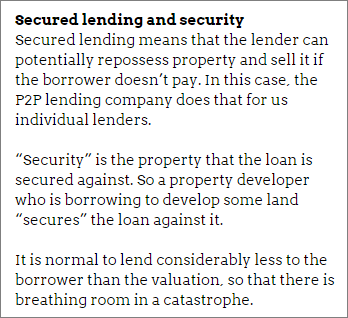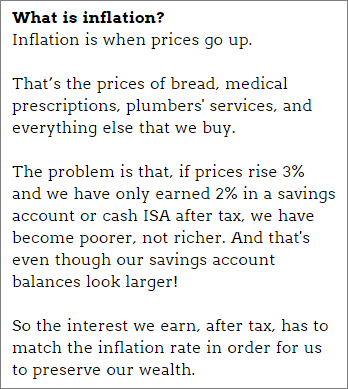To get the best lending results, compare all P2P lending and IFISA providers that have gone through 4thWay’s rigorous assessments.
Why I Prefer Shares to Higher-Risk Lending
Yesterday I wrote about why I stick to low-risk P2P lending.
Today, I want to write about why I look to shares for my higher rewards.
To me, there's no competition when choosing between higher-risk P2P lending and the stock market.
Regarding high-risk P2P lending, I find it impossible, most of the time, to make a good estimate of whether an interest rate is high enough for the ample risks involved.
Higher-risk lending is lending to borrowers that are not sub-prime. Or, if the loans are secured , the security is less than excellent. (See sidebox for definitions of “secured” and “security”.)
, the security is less than excellent. (See sidebox for definitions of “secured” and “security”.)
These opportunities generally have 4thWay®Risk Ratings of 20 or more.
What I want to know is: if I lend across hundreds of similar loans like this, and at the current interest rates, will those rates be enough to protect me from a major disaster, such as a recession?
And I don't know. I don't have enough information yet.
So I don't do higher-risk lending.
The best investors in the world focus on reducing risks above all else. This means if they have any worries at all that the investment they're contemplating will make them poorer then they avoid it. This strategy boosts returns by reducing losses, it makes investing easier and it means you sleep easily at night.
There's more on sticking to low-risk lending in yesterday's article, as well as my exception to the rule.
But now let's look at why I choose shares for the part of my portfolio where I take higher risks:
Share investing is incredibly easy
Yes, it is!
I know that's not what you normally hear. “Share investing is easy? How come so many people lost 90% on bank shares during the financial crash then?” you're probably asking.
Let me rephrase that then: share investing is easy for those who choose not to do high-risk, high-return.
This is beginning to sound familiar, isn't it?
There are some very simple strategies for investing in shares that control the risks and are highly likely to lead you to satisfactory returns. Not astounding returns. But good ones that grow your wealth.
Before I share those strategies with you, I want to explain why it is that shares are my preferred way to grow my wealth over a very long period.
Why shares are the growth investments
The inherent nature of the stock market is almost unique in that it is bound to grow and outpace inflation considerably.
considerably.
Businesses, unlike many other assets, actually produce things. And they tend to do it better as time goes by. And when they can produce more, better, they tend to become more valuable.
So it's unsurprising that long-run investment returns support that shares are the outstanding asset to hold when you have a long time ahead of you.
In the 114 years since 1900, the rewards of share investing have been phenomenal. They've seen a 300-fold rise. That's before deducting investing costs but after accounting for inflation (since it is businesses that pass inflation on to consumers by raising their prices).
Compare that to cash savings, with which you'd have been lucky not to have lost money. If you know what bonds are, they've only gone up maybe eight times over those 114 years. After investing costs making any money would have been harder still.
You don't have to pass a century to expect good results. In most 20-year periods, share investors have been rewarded with satisfactory or even excellent returns.
If this website was about share investing, I could go on with more statistics to expand on that further. But suffice it to say that, so long as we continue to expect business to grow, holding shares will continue to do us good.*
Safe share investing strategy
But I can't in good conscience just tell you share investing is better than high-risk P2P lending without telling you a safe strategy to take you to the right place.
So here goes.
Safe share investing is rather like safe P2P lending. With simple strategies you can expect to get good returns for the risks you take. With P2P lending it means lower returns and only short investing horizons are required. With shares it means higher returns and very long investing horizons.
With share investing, four simple techniques ensure that you don't invest all your money at the top of a bubble and that you're investing cost-effectively at cheaper prices, so that your expected return, overall, is likely to be satisfactory:
1) Invest for a long enough period
In contrast to safer P2P lending, you really need to have a very long investment horizon for share investing. If you can invest for 20 years, your chances of losing money are reduced.
But not eliminated. You can still lose money. That's something that many share investors don't realise. I think it's due to low quality research from big name companies.
Very high quality research from Professors Elroy Dimson, Mike Staunton and Paul Marsh of the London Business School, published in the Credit Suisse Global Investment Returns Sourcebook 2014, shows that, out of 20 world stock markets, only five of them have never lost after inflation over a 20-year period between 1900 and 2013. And that includes dividends.
Seven of the stock markets have lost over 20 years between roughly a quarter and a third of the time!** And that's before deducting your costs of buying, selling and holding shares or share funds.
Clearly the risks of stock-market investing cannot be underestimated.
The good news is that you still have three more strategies to greatly reduce your chances of losing money and greatly increase your chances of getting satisfactory returns. Here are the remaining three:
2) Invest regularly using your spare monthly income
You might invest some money today and it might be worth less in 20 years, but you also invest some next month, and the following month, and the month after that.
If you bought at a peak in the first few months, in a year you might be buying in a trough. Whenever your own peaks and troughs, on average, you can expect to buy at prices that are just fine. Losing over 20 years with this strategy is incredibly difficult.
3) Spread your money around
Maybe you've been worrying about buying the right companies.
But it is not necessary to know which companies will make efficiencies, keep up with new advancements and grow.
It is merely sufficient to invest across a wide range of businesses to ensure you capture the general trend of advancement. Buy a basket of many hundreds of companies to spread your risks.
4) Lower your costs
And keep your costs down so you don't destroy your gains. Index tracker funds are the cheapest way to spread your money across lots of businesses. Look them up.
*You could continue your research by reading about Warren Buffett's essay on business growth and share prices.
**If you're interested, UK stocks have lost over rolling 20-year periods approximately 5% of the time, but do not assume this will be repeated. The future will almost certainly be different. It is highly advisable to invest across many different stock markets, which will greatly reduce your risk of losing over longer periods. Currency risks, over the long run, tend to wash out and make the portfolio safer, according to the same professors I mentioned earlier. Stock markets in countries that are better regulated, less corrupt and with better corporate governance usually perform better than emerging, or other exciting, markets.


